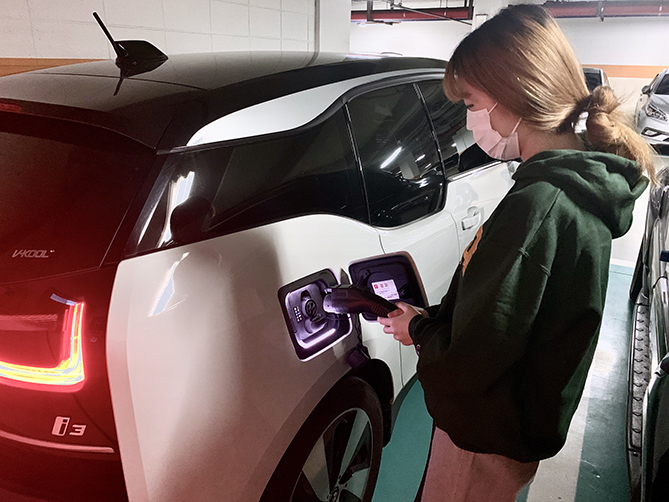When I was in elementary school, my teacher often talked about how new technology would revolutionize our lives in the future. However, no one in my class could have imagined cars powered only with electricity. An electric vehicle (EV) is a vehicle which uses one or more electric motors for propulsion. As they don’t produce greenhouse gas emissions, EVs have become common all over the world, including South Korea.
About one year ago, my dad bought an EV. Everything about it was new to our family, including the way it charged. I was surprised that it didn't make any noise when we were driving. and that we could charge the car in the parking lot of our apartment building. As the number of EVs are increasing in Korea, almost every public place, such as city halls and parks, have installed or are planning to install a charging station. The problems I found with EVs are that it takes time to charge them, at least more than an hour, and we can’t drive as far as we did on a diesel car. However, I became interested in learning more about EVs and their history.

To learn about EVs, I read a book called Future Energy Improved, Sustainable and Clean Options for Our Planet (3rd edition) written by Trevor M. Letcher and Energy Big Bang written by Lee Jong-heon. People might think that vehicles powered by electricity were developed only recently, however, at the beginning of the automobile's history, there were two main competing types of engine-driven vehicles: internal combustion engine (ICE) vehicles and electric drivetrain vehicles. The first electric car was created by Thomas Davenport in 1834. Many years later, in 1899, a rocket-like electric car was built and exceeded 100 kilometers per hour for the first time in the world. These facts astonished me. Who could believe that an EV had already been invented more than 100 years ago? Even though there were some problems, such as high prices, inconvenience of charging, and short mileage, by 1900, EVs had grown to nearly 40 percent of the U.S. auto market. In comparison, the internal combustion engine vehicle was invented 58 years after the electric car.

“Technology responds to needs and to price.” This quotation from Future Energy Improved, Sustainable and Clean Option For Our Planet sets out mankind’s path toward constant progress. Of course, there are many challenges ahead, and commercialization will take a long time. But history is a series of challenges and retribution. Whenever there is a desperate need, technology is bound to rise to the challenge. Thousands and millions of years from now, people will need new energy sources. In terms of energy, we are still in the Second Industrial Revolution stage. Although the use of electrical energy has increased a lot, electricity is still mainly generated from coal and oil, the fuels of the first and second industrial revolutions, which are limited. New energy, which can help us prevent harm to the Earth, will also need to be replaced someday. According to the book, seven countries, including South Korea, the U.S, European Union, Russia, Japan, China, and India, are jointly building large nuclear fusion reactors,- in the form of international thermonuclear experimental reactors. Unlike conventional atomic power generation, fusion technology produces little radioactive waste and has little risk of accidents. It also produces very little greenhouse gas and fine dust emissions, and the water required is available in infinite supply in sea water.
Because it is so convenient, electricity is becoming more and more common. Now, new electrical products, such as EVs, have been introduced in response to climate change, along with devices of the Fourth Industrial Revolution. These products and devices seem eco-friendly? as they produce no exhaust gases at all. However, unfortunately, high electricity use does not reduce the use of fossil fuels. In fact, the more electricity they use, the more fossil fuels are consumed. because that electricity is mainly produced using coal. If electric cars are the trend of the future, shouldn't we be asking questions and seeking answers about how that electricity will be generated? It is thus my hope that -‘the international thermonuclear experimental reactors’ being built achieve success and change the world.

Haram Yoon
11th grade- junior
Holy Trinity Catholic High School (TX)

